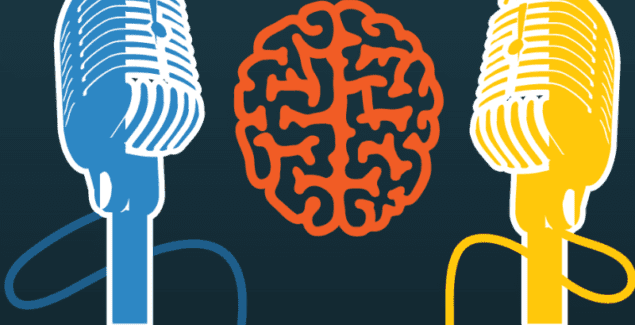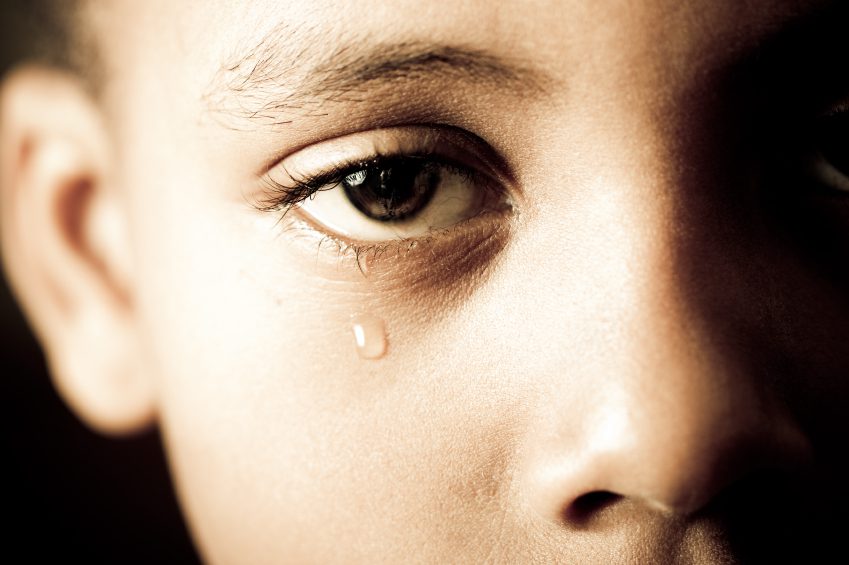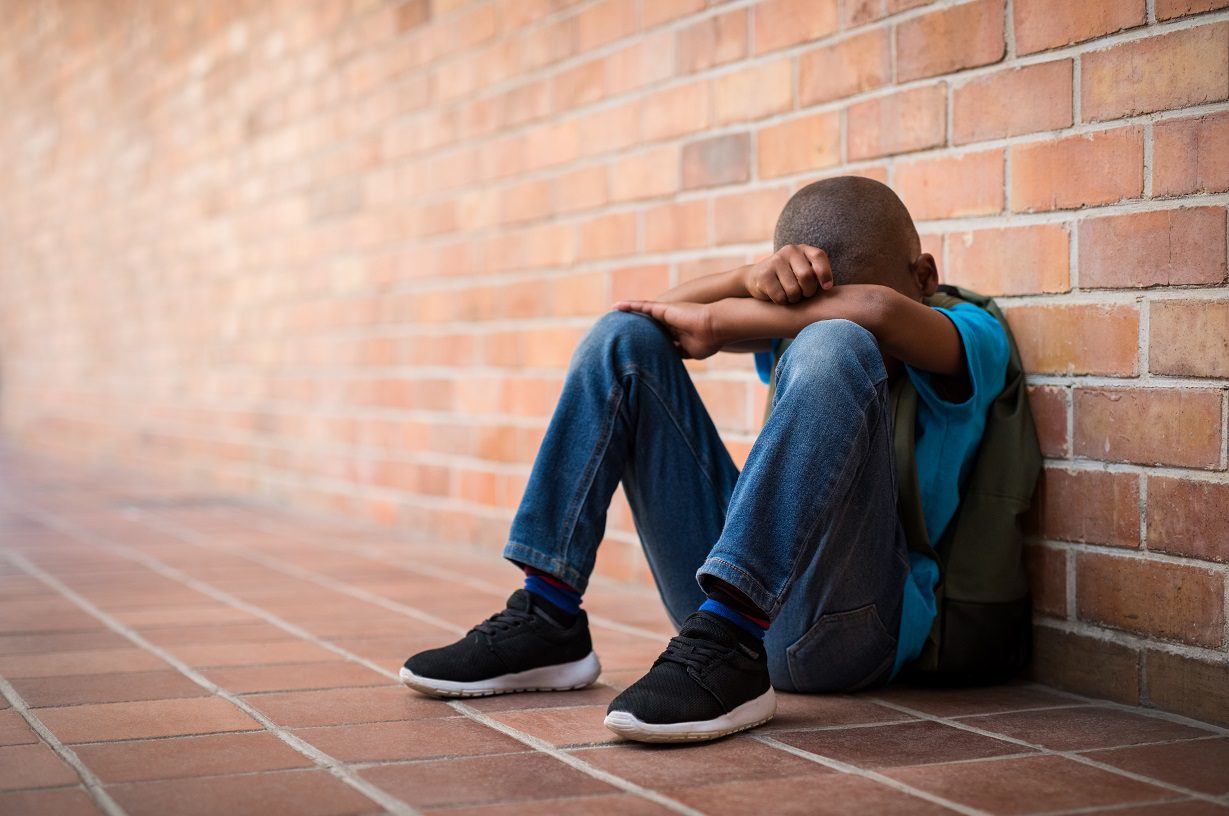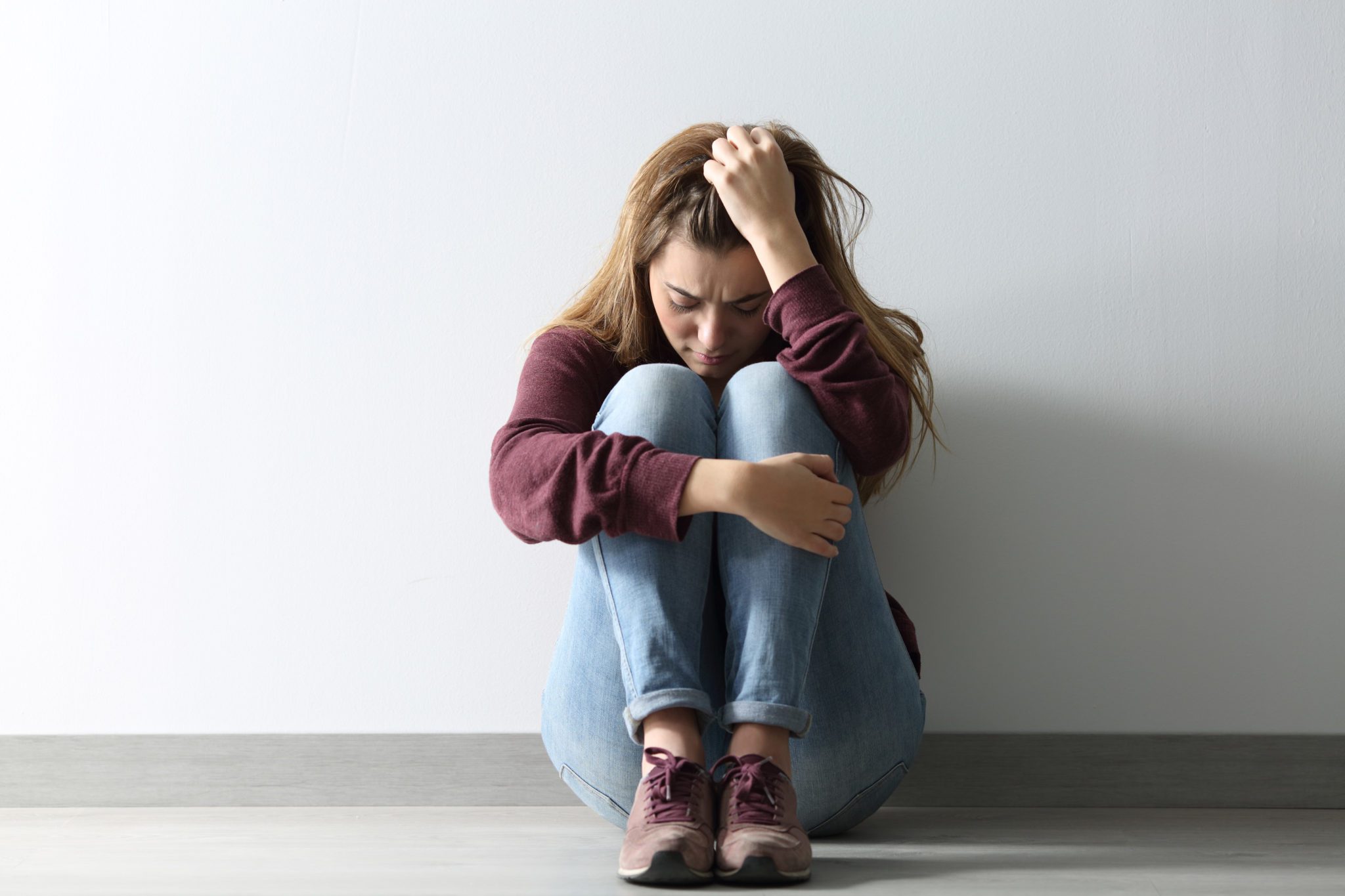How Should We Respond to Anxiety in Our Kids? feat. Kevin Simon, MD

Posted in: Multimedia, Parenting Concerns, Podcast
Topics: Anxiety, Hot Topics, Stress
Anxiety. Unhealthy levels are rising in our kids and teens. What can we do to help them? On today’s episode of Shrinking It Down: Mental Health Made Simple, Gene and Khadijah are joined by very special guest Dr. Kevin Simon, the first Chief Behavioral Health Officer for the City of Boston, to help make sense of it all.
Dr. Simon draws on his experience in child and adolescent psychiatry, addiction medicine, health policy, and more, to help us talk through the issue of childhood anxiety. What’s the right way to respond to a child experiencing anxiety? Why does parental accommodation sometimes make things worse? How do we reassure kids whose anxiety stems from legitimate concerns, like community violence or discrimination? What’s the role of public mental education in supporting families and communities? All this and more.
Tune in and share with a friend. And be sure to check out the additional resources below.
Media List
Follow along with the conversation.
- Kevin M. Simon, MD, LLC
- Dr. Kevin Simon Appointed First Chief Behavioral Health Officer (City of Boston)
- YRBS Data Summary & Trends Report, 2011-2021 (Centers for Disease Control and Prevention)
- What If My Child Has Anxiety? (PDF – MGH Clay Center)
- Anxiety to Agency: Empowering Kids to Address Climate Change (MGH Clay Center)
- Building Mental Wellness in Children: What Parents Can Do (MGH Clay Center)
- School Refusal: When Back to School Is a Nightmare (MGH Clay Center)
- Collaborative Problem Solving for Parents (Think:Kids)
- Anxiety: Support Your Child at Home (PDF – MGH Clay Center)
- What is Cognitive Behavior Therapy (MGH Clay Center)
- Disparities in Pediatric Mental and Behavioral Health Conditions (Pediatrics)
- Child Psychiatrist on How to Address Suicide Among Black Youth (NowThis News)
- Calling 988 Can Get You Help During a Mental Health or Substance Abuse Emergency (NECN)
Tune in the Third Thursday of every month for new episodes. Like what you hear? Leave us a review!
Transcript
SPEAKERS: Gene Beresin, MD, MA, Khadijah Booth Watkins, MD, MPH, Kevin Simon, MD
Kevin Simon, MD 00:00
And it becomes a habitual thing and that the parent responds. And I tell parents like, you’re accomodating every time that they come you trying to quell your own anxiousness about well, okay, let me solve that now. Now broadly in terms of just responding about anxiousness.
Kevin Simon, MD 00:19
I do try to tell parents that they should create an environment where their son or daughter can regularly know that they’re going to engage in some kind of conversation about emotions, feelings, and that if you can create that habit that you’re, you’re the parent is going to be receptacle.
[MUSIC INTERLUDE]
Gene 00:44
Welcome back to Shrinking it Down. Mental Health Made Simple. I’m Gene Beresin.
Khadijah 00:49
I’m Khadijah Booth Watkins.
Gene 00:51
We’re two child and adolescent psychiatrist at the Clay Center for Young Healthy Minds at the Massachusetts General Hospital. And today, we have a very special guest. We’re honored to be joined by Dr. Kevin Simon, the very first chief behavioral officer for the City of Boston.
Khadijah 01:09
Yay.
Gene 01:10
It’s about time, you know. And a good pick as well. On today’s show, Dr. Simon is going to help us learn more about childhood anxiety. More on that in a bit. But first, welcome, Kevin. It’s great to have you here.
Kevin Simon, MD 01:26
Yeah. So thank you, Gene or Dr. Beresin.
Gene 01:29
We’ve known each other we’ve known each other for a long time, so we don’t have to be formal.
Kevin Simon, MD 01:35
So it’s a pleasure to be here, and to engage the audience. So thank you for having me.
Khadijah 01:41
Thank you for joining us. And, and in addition to the newer role as chief behavioral health officer, Dr. Simon is also an attending psychiatrist at Boston Children’s and instructor of psychiatry at Harvard Medical School, a Commonwealth Fund fellow in health policy at Harvard, and the medical director of Wayside Youth and Family Support Network. Clinically, he practices as a child, adolescent and adult psychiatrist and addiction medicine specialist, caring for youth, young adults and families at Boston Children’s Hospital. It is my hope today that in this conversation, we’ll learn a little bit more about the work for the city of Boston. But before we launch into that, can you tell us a little bit about how you got here? You know, what got you interested in psychiatry and working with youth and families?
Kevin Simon, MD 02:25
Yeah, thank you for the question. And I guess in theory, I should start with my own family. And so for those who don’t know, so I’m really from Brooklyn, New York, son of Haitian immigrants, and my dad, Reverend McClair, ASIMO. He was the first Black or African American deacon in archdiocese in Brooklyn. And so, very early, I got exposure to ideas and concepts related to whole person health, mental health, psychological health, kind of seeing him engage with people. So that’s, I’d say, the first inkling was actually from home. But then, you know, more traditionally, going through school, and eventually medical school, psychiatry was the field that required us to think holistically about a patient’s life because it couldn’t just be like, potentially some other organs. You can’t just say, Okay, well, how’s your mind today? And not at about school? family relationships? How old is it you’re eating? How did you travel to where you are? So psychiatry, was the field that most interested me. And then, you know, when you’re in our field, you recognize, oh, even though we start off with adult training, most of the conditions we help with start off in adolescence. So recognize that I needed training with adolescents. So I did my adult training at Morehouse School of Medicine that’s in Atlanta, trained at Grady, then came to Boston Children’s to do child psychiatry.
Kevin Simon, MD 04:11
But you realize, when you’re engaged with families, you might say, you know, you should walk 30 minutes a day, or you should do some some behavioral activity. And then you realize, wait a minute, that family doesn’t even have the opportunity to engage in that behavioral activity because of zoning restriction. And so you realize how much policy actually implicates the kind of life that people can lead to then policy became an interest of mine. I try now to fuse all those together. And, yes, Mayor Wu and that the Dr. Ojikutu, who’s the commissioner for the public health executive commission for the Public Health Department, thought about behavioral health and recognize the growing demand in our city, let alone in the nation. And I was fortunate to be in a position to have experiences in a multitude of domains.
Khadijah 05:09
That’s awesome. We’re lucky to have you.
Gene 05:12
Yeah. And welcome to Brooklyn. <laugh> I’m showing Kevin, a poster, a postcard that I have up on my on my shelf. About Brooklyn, I have a lot of family from Brooklyn. So in turning to our topic for today, maybe we can start talking a little bit about anxiety and kids. It’s a topic on everyone’s mind, you know, some feelings of anxiety are common in young people. And in fact, a little bit of anxiety improves performance. But when it gets excessive, kids as well as adults get into trouble. And there’s a lot going on in kids lives today, developmentally, socially, politically. There are a lot of worries and concerns and challenges they face. But looking looking at the data that the CDC that is the Center for Disease Control, the trending data, that is the Youth Risk Behavior Survey that they looked at, which is given to ninth through 12th graders, from 2011 to 21, was really worrisome. It shows that that rates of anxiety are going up and kids, and we will see patients here to Mass General. And, you know, Kevin, have you seen an upward trend in the anxiety of the patients and families that you work with?
Kevin Simon, MD 06:33
Short answer is yes. As Khadijah mentioned, I primarily operate through the ASAP program at Children’s but I still do cover our emergency room. And I can’t say that, certainly over the pandemic, but even if it was occurring, even pre pandemic, there definitely has been an uptick in terms of the number of youth who show up with behavioral health concerns and of concerns. The most common one is anxiety. And so you know, to your point, anxiety actually isn’t normal. It isn’t normal feeling we should experience right, I get anxious that I’m coming on this podcast, and oh my gosh, how am I gonna sound right? Like, there’s some normalcy to anxiousness, but seemingly, a lot more kids are experiencing a higher level that becomes so distressing that they’re not really functioning, you know, sometimes can’t go to school. Certainly seeing you’ve been absent from school part of, again, fear for quite some time. So I do want to hear these. But the answer would be that yes, I have seen an uptick in the number of youth who present to our clinic, and as well as just to our emergency room.
Khadijah 07:51
And I would say in addition to that, absolutely. And some some to some degree, you know, I’m still seeing social anxiety, I’m still seeing generalized anxiety, but some of the themes have also changed a bit. Like there’s increasingly it seems like more concerned about safety and violence, you know, with all of the tragedy that’s going on around us, you know, worries about their future, and will there be a planet here that’s going to be sustainable for them with respect to climate change? And so I see a little bit that the themes are changing, but the anxiety itself, and like you said, it, it proves that it predates the pandemic, but it just seems to be correct, continuing to worsen.
Gene 08:27
I agree, I think you know, for example, more young people, middle school through college, that I’ve see, or concerned about, in know, the world that they’re inheriting. You know, they’re they’re much more I mean, I don’t have a single conversation that doesn’t talk about Black Lives Matter about racism about disparities in in accessing care, and will the economy allow me to kind of have a family have a home have a safe place to live? You know, I mean, especially for for for low income people. And for those people of color, who live in communities where the water the air are just not taking care of it in effects, in my view, a lot of kids. If I were a kid today, I I’d be worried about what I’m inheriting.
Kevin Simon, MD 09:22
No, you gene, as you say that, and you mentioned racism, something that I’ve experienced is a number of families where there’s interracial adoption or interracial fostering. And to my mind there’s two families were the sons, you know, between six and eight, and son is African American parents are not. And during an urgent call, you know, they’re they’re telling me that when their kid came from school, one occasion and kids came from the park on the other occasion that casually on their drive home, this the sons revealing language that was used towards them. And the parent really not knowing, like, how do I respond back? And so what I recognize is also a significant amount of parental anxiety in terms of having their son now experiencing the world. And what does that mean, right? And how is it that I respond? I can’t say, oh, I’ll tell them that will never happen. Or tell them to accept it as normal. Right? So as you brought that up, if that brought up to sailing families in my mind.
Gene 10:44
Well, it’s interesting – Go ahead, Khadijah, I’m sorry.
Khadijah 10:48
I was just gonna say it’s a tight rope that parents who are raising kids of color, have to constantly walk around, encouraging them and being hopeful, but also or, and also, you know, preparing them for the world that actually they live in, and how to strike that balance without instilling fear and, and, and preventing them from going out and taking risks. It really is a tightrope that we have to walk in, and it is incredibly anxiety provoking, we’re all anxious, you know, all parents and kids, we’re all really anxious.
Gene 11:20
But I think, more than ever, and what we try to do, and the reason the reason we have these podcasts is to help parents talk with their kids is, is what do you say to them? How do you tell them? How do you inform them? That you know, to deal? How do you how do you help them deal with the realities of life? And how do you help them thrive?
Kevin Simon, MD 11:48
It’s a, I think, this is where the challenge comes, because in our field, right, we’re trying to contextualize what people are telling us in the context of the environment in which they live in. And it is challenging, right? Because what one person’s anxiousness might be another person is, that’s, oh, that’s just Tuesday. So I think for myself, when I’m encouraging parents that have youth who may be anxious, one thing is to recognize, if your youth is anxious, there’s a very strong chance that you’re going to be anxious. And you got to recognize how you respond is as much about you the parent, as it is about the youth. And so I’ll give an example here.
Kevin Simon, MD 12:44
Mom with a 9-10 year old, who consistently gets out their bed, and like knocks on the door. I want water, you say okay, here’s your water. 10 minutes later knocks on the door, oh, it’s so dark in my room. And it becomes a habitual thing, and that the parent responds. And I tell parents like, you’re accommodating every time that they come. You trying to quell your own anxiousness about, well what is it you pining about now? Okay, let me solve that now. And I say, while you are accommodating, you’re also like giving either positive or negative feedback and you’re just building this up. And so in that instance, actually, very neutrally, don’t engage in this, bring them back to the bed. And when they come back again, neutrally, bring them back to the bed. And eventually you will burst that behavior. Now broadly, in terms of just responding about anxiousness. I do try to tell parents that they should create an environment where their son or daughter can regularly know that they’re going to engage in some kind of conversation about emotions, feelings, and that if you can create that habit, that you’re, you’re the parent who’s going to be a receptacle. You don’t want to course correct, just listen to listen, when that issue comes up down the line that you really want them to come to you and talk about and not necessarily go to their their friend or you know, the internet, they would have built that habit of engaging you. So that’s one of the things I do encourage parents is to try to set aside time weekly, it doesn’t have to be daily, but weekly, where you say, oh, you know, this is just talking about whatever it is that you want to talk about, and making a normal engagement. It does become the six year old that oh, yeah, I want to tell mom this for seven years. Oh, yeah. I’m gonna call my dad. We normally do this. And it starts really early, because by the time sometimes they engage a provider like us, and they’re bringing up a concern, but they bring up the concern that you know, 16. And we do our history, we come to realize, oh, yeah, oh, it started at five. Okay. So I’m gonna pause this because talking a lot.
Khadijah 15:18
No, this, this is great, because I think we talk, like Gene mentioned so much about the importance of conversation and having them frequently, and having them in a way that is normal, that creates the platform for kids to feel comfortable coming to us with anything. I want to go back just a minute to the idea of what parents do. And parents by foreign large want to do what’s best for their kids, we want to do what’s best, we don’t want to see our kids structure suffer. You know, we see it often also, like in school refusal, and school refusal is often related to anxiety, but not necessarily but you know, parents will see their kids suffering and struggling to go to school. And then we’ll say, okay, you don’t have to go to school today. Well, we’ll try again tomorrow. And once they have that relief of anxiety, it’s really hard for them to not be in reinforced. So then you look up and it’s been five days, 10 days, you know, three weeks, they haven’t gone to school. And as a parent, you really feel like you’re doing what’s best, because you’re relieving your child of suffering. But there are downsides. And so is there a such thing as being over accommodating? You know there is a thing as too much of a good thing. But can we over accommodate?
Gene 16:30
I do think there is I think that the model that I think I look to in this is of kind of a variation of collaborative problem solving, is that, you know, when there’s something at stake, whether it’s some extra time to play a video game, or some we’re putting off homework, or we’re not going to school, because you’re upset about something, or having to go to an appointment, which I think really important, is that the parent, I think you’re you’re right on target, Kevin, when you say we got to control our own anxiety for the weekend, kind of like deal with the child in his calm and collected as soon as we can. But find out what their wishes are. They hear what our wishes are. And then it’s a process of negotiation. So the accommodation actually becomes a collaborative effort in making it a win win situation. And I think that can be applied to anxiety to fears to all sorts of kinds of situations that we that we deal with, at home and at school and and yard in our spiritual communities everywhere. What do you think?
Kevin Simon, MD 17:43
Yeah, yeah, no. So I love the fact that you just said, collaborative. I’ll give a personal example that hopefully can be helpful. So I have two kids once 4 going on 24 and the others 22 months. The 4 year old, that’s my daughter. She really likes, as most kids do, right? She really likes sweets. And she will want to have sweets before other stuff. And so she might say, Oh, she know that I really want ice cream. I know, I want ice cream too. But we got to eat dinner, you know, while he’s made dinner. And there might be some frustration that she expresses. And what we’ll do collaboratively is saying, Okay, now I know that there’s just more than sweets that she enjoys. She also enjoys that we kind of read at night to you. So it’s like if we just say no, that’s not really gonna be helpful. So it’s okay. Hey, if we have this ice cream right now before dinner, what can’t we do afterwards? Do you not want to, you know, have mommy and daddy read at night? Do you not on a watch one of the there’s a thing on YouTube number of blocks that she loves? Do you not want to watch number of blocks? What’s the thing that you don’t want to do? But you can have dice right now. And then given her time to think she’s only 4, but going on 5. Think, well, but you can have the ice cream still. But after dinner and still all those other things. Then it becomes like, oh, wait, okay, I can eat dinner. But I am providing her the other things that she might have in her blind spots. I think for a lot of parents, when the child is engaging with us, and we want to provide that immediate answer or solution. Yeah, if we if we pause and take a step back or just take a couple of extra seconds and say okay, how else can we both get the thing that we want and work collaboratively together to to do that. And I do encourage a lot of parents to recognize the agency that they have as the parent within their household. So I really love the fact that you said, collaborative.
Gene 20:09
So, it is collaborative. And I think that I wish that all parents could do that. Are there some specific things? Can they you know, speaking of anxiety, or there are some tips that you would offer parents to help their kids manage cope with deal with the anxieties that they’re facing in everyday life? I know that that’s a big question, because it’s different for a four to five year old than it is for a 10 year old from a 15 year old. What are the some specifics things that we as parents, caregivers, teachers, coaches, clergy, talk with our kids about? To kind of reassure them?
Kevin Simon, MD 20:51
Yeah, so I think it is true that there are different ways and there’s different types of forms of anxiety. Rather than that there are some universal practices that we all could engage in, that would be undoubtedly helpful to us. So one is positive affirmation to the youth, we can always ask the question of the again, depending on the age, what’s the feeling that they’re having. And I think there’s sometimes a tendency suggest that someone shouldn’t be having a feeling, right, so you shouldn’t feel anxious about this. And it’s why I think earlier, in the episode I mentioned, like anxiety is a feeling we all actually should recognize and be able to recognize and understand it. So affirming that your youth is anxious, is actually helpful. Could it make them feel like okay, wait a minute, I’m not thinking this in the wrong way. Okay. So I am anxious. Okay, now that we’ve agreed, and you’ve recognized that I understand it. Now, let’s think about in a cognitive behavioral therapy to kind of let’s think about, Do you have evidence to be anxious? Right? Let’s say it’s a social anxiousness. Okay, who’s going to be there? Oh, well, Gene is going to be there, Khadijah’s going to be there. Like, okay, are those your friends, Kevin? Well, yes. Okay. Has Gene or Khadijah ever given reason for you not to feel it that your friends? No. Okay. And you start to actually, in a very, like, grounded kind of way, demonstrate that potentially, the feeling of anxiousness that they’re having doesn’t align with, like, the objective fact of Gene has not been, a not different to me. And so then hopefully, that can help when you ground them in the objective fact that oh, okay, this is actually not that bad. Or if it’s a sporting event or practice, right? You know, sometimes you don’t want to engage in something. Like, well, okay. You didn’t want to engage in it last week. But then you did. How did you feel after that? Oh, you know, actually practice wasn’t that bad. Okay. Remember, you didn’t want to engage in it 2 weeks ago. Yeah. Okay. How do you feel after that? Okay, it wasn’t that bad. So sometimes you have to help them recognize that the feeling is going to come and be present, because anxiousness is a normal feeling that all of us have, how we respond to that anxiousness. That’s where things can deviate.
Kevin Simon, MD 23:37
And then also, and this is really more therapeutic, and potentially not as applicable. But sometimes we recognize that the feelings that we’re having and how we’re thinking about the anxiousness or the environment, and this is where therapy is helpful, is you can start to actually name the type of feeling we’re having or thinking that we’re having. Oh, it’s like, wait a minute, wait, you’re not gonna feel because this is this is an example. So I’m gonna do horrible Wait, oh, how do you know that you’re gonna do horrible? Well, the teacher doesn’t like me. Can you think for your teacher? It sounds like you’re fortune telling here. And so sometimes you give examples of the words that you’re saying. Like, there’s no way that I could know that my teacher does or doesn’t like me. Right. So I do think affirming somebody and acknowledging that yes, the anxiousness that you’re feeling, you do have, so that way they recognize Yes, okay. Yes, I have you say yes. So you providing them comfort in knowing that they’re not alone in it, and then you can ground them in, is it worthy or or not worried is the wrong word, but is it more real that your friends in the case of this is your friends don’t like you for that test is really going to be really, really hard? Sounds like you’ve been studying, you know, so there’s ways to have a fluid conversation anchored and objective truths of the youth that can then help them recognize, oh, wait a minute, okay. I am feeling a little bit nervous, but I still can go through the test or the friendship to practice. And when you go through that enough times, it won’t be the thing that causes anxiousness.
Gene 25:26
So what you’re doing, actually, Kevin, is your I think, identifying that, validating the feelings, providing reassurance. Emphasize, you know, trying to find out what the, what the kid is worried about. Friends will like you teaching us like, you are not good enough. And then using targeted behavior therapy in real life, to kind of correct the the cognitive exaggerations? And is the thoughts that are excessive, that are distorted or exaggerated, or even catastrophic. And helping the kid realize that it’s it’s, it’s not as bad as it seems.
Kevin Simon, MD 26:05
Right. Khadijah, thoughts?
Khadijah 26:08
I don’t have any additional thoughts. Yeah, I think it really is about helping them like almost like challenging the thoughts a little bit in a way that is, you know, warm and kind. And still validating their fears, their fear, but helping them to break it down a little bit. I think that it’s really, really helpful. And it’s a delicate balance, again, because you want to make sure that you’re you’re being validating, and you’re and you’re not being dismissive or condescending, which can be be challenging when you don’t understand. So really taking the time to understand that the the, where the fear is coming from managing your body language and your nonverbal, you know, communications is really important. Can we stay here a little bit as we were thinking about like interventions, and think about, like, as I’m thinking about, like interventions and parental responses, surely, we have to think about the differences, and the background and the life experiences and how they factor in. And so I’m gonna get on my soapbox a little bit. And you mentioned that a little bit when you talked about, you know, racism, and how that impacts kids and families, and just their ability to kind of carry out like maybe what our recommendations are. In the field, I think as a whole, we haven’t done a great job as it relates to thinking about and factoring in the experiences of, you know, whether it’s experienced racism, whether it’s experiences of living in a place, it’s not safe, where you don’t have, you know, safe spaces to walk around, or you don’t have access to food desert, you don’t have access to healthy food. And as a as a field, we haven’t done a good enough job, I think, you know, taking those things into consideration, and thinking about how they might impact our patients and our families. And so, as we’re talking about parental intervention and responses, how do we factor these things in, I mean, as as the chief behavioral Officer of Boston, you’re tasked with overseeing a city that is tremendously diverse in terms of his populations, which also means they have different sources of anxiety, you know, their kids come from different backgrounds. So some kids are, you know, anxious about social issues. Some kids might be anxious about, you know, the community in which they live and violence and gun threats, where some kids are anxious about discrimination. And then there’s the things that kids are anxious about, in general, you know, whether they’re going to have a job, you know, climate change, there’s no shortage of things that our kids are anxious about. And so then how do we approach it differently? Maybe based on the background?
Kevin Simon, MD 28:29
Yeah, no. So this is a very good point that you’re bringing up. And it’s not a soapbox, but it’s important. I think in terms of thinking about. So sorry to like nuance it. In the field, this will be the idea of like, the Cultural Formulation, right? Like, in theory, some people come from different cultures. And so you’re trying to be mindful of that. Yet. The reality is, cultures, there’s many different cultures, even outside of just ethnic culture. And so, yes, if I engage with a youth who’s actively incarcerated, but the sharing culture aspects that I have to ask about, versus Yes, that’s different than someone who’s in the community. And so as as practitioners, we do have to be very mindful. That I think, really is what our job asks us, you have to be just inquisitive about the experience, right? Because the reality is, it is impossible for us to move forward and have complete one to one ratio, concordance, ethnic concordance provider to family, right. Even within families I mentioned, there’s sometimes interracial dynamic, so being open and truly with an inquisitive mind about okay, let me understand or help me understand what it is that you are experiencing is important. Even intergenerationally in the same family, right? So a parent to youth. Just because you are a parent, you were you at some point in time, but it was at a different point in time than your youth now, right? And so it’s actually not fair for you to try to compare what occurred, sometimes in your past to your youth’s present. My parents didn’t have a TikTok, they didn’t have an Instagram, they didn’t have a Facebook. And so in staying in the learning frame, they should be curious about what what is this? Right. So that way helped me understand. Alright, so hey, you know, Kevin, seems like you spent a lot of time engaged in social media. If they just ask the question, and I hear this from youth. If they just asked me, I tell them. And so it’s like, so if you just ask the question, be in the learning frame yourself as a parent, you’d be very surprised, your youth likely will give you the answer about why it might feel important to them about engaging in social media as an example. And they also may recognize when things are not actually healthy. And the fact that we asked them, if we as parents stay in a learning frame. And as clinicians stay in a learning frame, you can engage with a person from a completely different background than yourself. But learn something from them that can be helpful for them to think about, Okay, how’s this a shift that I might want to make that might make me feel different about a situation.
Khadijah 31:43
And I think – I think it’s just so important, because I think that cultural sensitivity and that curiosity is so important, because it’s going to be tremendously hard to find providers that look like you for all kids and families. And so if we stay, you know, sensitive and curious, you know, we won’t tell kids things like, don’t worry, you’re going to be safe, if they live in an unsafe neighborhood, like it could be so incredibly, you know, again, invalidating, and it tells the kid in the family that you don’t understand me, you don’t get me you don’t see me. So how can you help me if you don’t understand that my community is not safe, or I don’t eat fresh fruit because I don’t have a place where I can get them from. And so those things can be really detrimental to the therapeutic relationship and cause people to not show up and create a real barrier. So I think it’s super important that we think about the things in this way as as parents as caregivers, and as people who are anyone who’s supporting a young child or young person.
Kevin Simon, MD 32:41
Yeah, Gene, before you jump in – what we’re talking about here in the therapeutic sense, and I think, more popularized by by one of our colleagues who, who’s no longer here, Dr. Paul Farmer, right, this idea of accompaniment, right? Like, as a, as a therapist, sometimes it’s the fact that I’m present with you experiencing the existence that you’re having, and that you’re not doing it alone, at least in the time that we’re engaged. And that I may actually not be able to figure out the problem. But you’re not at least figuring it out by yourself. And so when I’m wearing the therapy hat, really do acknowledge to us and to parents. I may not have all the answers, but at least we’ll be working together to figure it out. And I think that that’s what we’re talking about here in terms of the differences in social demographic differences, economics. But can you be as a provider, actually, just, like humble enough to recognize you don’t have, you don’t have all the answers.
Gene 33:57
So I’d like to go back to your notion of being in the learning mode, and the importance of mental health education, particularly for parents. So in your role, with the city of Boston, where we roll for the wayside youth and family, how are you approaching mental health education, which is so important, you know, for parents, kids, teachers, youth workers, even clinicians? And, and second, what barriers do you see to mental health education?
Kevin Simon, MD 34:33
Yeah, so these are good questions. I think in terms of the barriers, so one, accessing information about mental health that is accurate, because there’s a lot of inaccurate information that can be shared very widely and quickly. I think to Khadijah’s point about cultural nuances, right? Sometimes we will have very good information. Yet it is just not even translated in the appropriate language. And so here it is, I have great information. And I’ll actually I’ll give you an example here. So several weeks ago, I spoke to special education Parent Advocacy Council, SPED-PAC of the Boston Public Schools system. And it was awesome, because we were talking about ADHD and neurodevelopmental conditions, and has over 200 engage parents. And when we, when I logged in, they had 12 different rooms. And so it was like, if you spoke Haitian Creole, the translation room one, if you spoke crate, Cape, Verdean, Creole, room two, Spanish room three Chinese rooms, right. So they thought in advance, we know we have a diverse population, and parents are not all primarily English speakers, we’re gonna make sure that what however you’re coming, that Dr. Simon knows that he can’t talk super fast, because we have translators that are translating in real time. So in terms of the information, ensuring that we really do cater to the significant amounts of diversity of patient populations, families that we have, and ensuring that that information is accessible to everybody.
Another thing that I would say is, in terms of thinking at the city level, one of the things that we will be doing is intentionally having what we call the behavioral health communication campaign, to make sure that in a lot of different languages, on a lot of different platforms, right podcast included, that as many people as possible, hear the appropriate information, the right information, that can be helpful for them at the right time. Because there’s a lot of information to be shared. And I think when I’ve talked with a lot of community organizations, churches, individual person, they do share that they really want to have more information, because they don’t, they might know that their youth, something’s different, or the coach knows, I got a kid on my team that I don’t know how to really engage with. And so for us, the communication campaign is really about how can we educate and increase the understanding of behavioral health symptomology. So that way, just as much as people recognize, you know, this person, I need to be doing CPR, we become a city, that the general person can recognize somebody that is experiencing a behavioral challenge and feel more comfortable recognizing like, Okay, wait a minute, here’s this number that you should call. So that’s, that’s part of the education on a public health level that we’re thinking about.
Khadijah 38:06
So, you know, you are obviously incredibly passionate about supporting youth mental health on large scale, and we wanted to really, thank you for thinking with us and talking with us about, you know, anxiety as it relates to young people and how we, in our role as parents, um, and also for sharing, you know, what you see as the potential barriers and the opportunities that exist for mental health education, because we feel incredibly strongly that education plays a huge role in the way of addressing youth mental health. Is there anything that we have not touched upon, that you think is really important for us to not close out before we do?
Kevin Simon, MD 38:43
Yeah, I mean, I, you know, I recognize that this reaches a very wide audience, even though it’s outside of the greater Boston area. I think the fact that you’re a parent, a loved one, a caregiver who’s listening to this, kudos to you, because you are actively doing the work of trying to understand how to better yourself or potentially to help you for someone else. <background music starts> And, you know, hopefully, you all been back and we can talk about some other topics.
Gene 39:16
Thanks so much. It was a pleasure having me here today. I want to thanks, everybody, for tuning in. We’ll see you back on the 3rd Thursday of next month. If you like what you’ve heard, send us a review, ask us more questions. We’ll we’ll try to get them answered. And Kevin, we certainly will have you back. I mean, this is we’ve got so much more to talk about in terms of education, awareness. Mental health is such a big field. So as we, as we say at the end, we hope that our conversation will help you have yours. I’m Gene Beresin.
Khadijah 39:53
And I’m Khadijah Booth Watkins. Until next time.
[MUSIC INTERLUDE]
Kevin Simon, MD 40:02
Your parent, when I’m talking to the youth, like, you literally have a different parent than your sibling, because they have them at a different time, a different place and they’re in their own, you know, development. You literally have different parents. And I say that to parents, I’m like yes, I know they’re twins, but they actually have different lived experiences.
Khadijah 40:28
This age group, like I’ve heard people say like, I don’t know this parent. I don’t know this mom. That’s not the mom that I had, like, you hear it all the time. Yeah. Yeah. My son my older one try. They accuse me of such but I tell them that’s not true.
Episode produced by Sara Rattigan
Music by Gene Beresin

 Share
Share Tweet
Tweet







